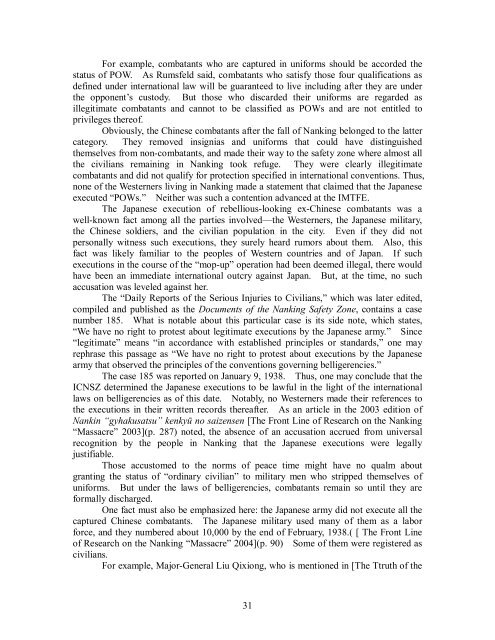Analyzing the âPhotographic Evidenceâ of the Nanking Massacre
Analyzing the âPhotographic Evidenceâ of the Nanking Massacre
Analyzing the âPhotographic Evidenceâ of the Nanking Massacre
Create successful ePaper yourself
Turn your PDF publications into a flip-book with our unique Google optimized e-Paper software.
For example, combatants who are captured in uniforms should be accorded <strong>the</strong>status <strong>of</strong> POW. As Rumsfeld said, combatants who satisfy those four qualifications asdefined under international law will be guaranteed to live including after <strong>the</strong>y are under<strong>the</strong> opponent’s custody. But those who discarded <strong>the</strong>ir uniforms are regarded asillegitimate combatants and cannot to be classified as POWs and are not entitled toprivileges <strong>the</strong>re<strong>of</strong>.Obviously, <strong>the</strong> Chinese combatants after <strong>the</strong> fall <strong>of</strong> <strong>Nanking</strong> belonged to <strong>the</strong> lattercategory. They removed insignias and uniforms that could have distinguished<strong>the</strong>mselves from non-combatants, and made <strong>the</strong>ir way to <strong>the</strong> safety zone where almost all<strong>the</strong> civilians remaining in <strong>Nanking</strong> took refuge. They were clearly illegitimatecombatants and did not qualify for protection specified in international conventions. Thus,none <strong>of</strong> <strong>the</strong> Westerners living in <strong>Nanking</strong> made a statement that claimed that <strong>the</strong> Japaneseexecuted “POWs.” Nei<strong>the</strong>r was such a contention advanced at <strong>the</strong> IMTFE.The Japanese execution <strong>of</strong> rebellious-looking ex-Chinese combatants was awell-known fact among all <strong>the</strong> parties involved—<strong>the</strong> Westerners, <strong>the</strong> Japanese military,<strong>the</strong> Chinese soldiers, and <strong>the</strong> civilian population in <strong>the</strong> city. Even if <strong>the</strong>y did notpersonally witness such executions, <strong>the</strong>y surely heard rumors about <strong>the</strong>m. Also, thisfact was likely familiar to <strong>the</strong> peoples <strong>of</strong> Western countries and <strong>of</strong> Japan. If suchexecutions in <strong>the</strong> course <strong>of</strong> <strong>the</strong> “mop-up” operation had been deemed illegal, <strong>the</strong>re wouldhave been an immediate international outcry against Japan. But, at <strong>the</strong> time, no suchaccusation was leveled against her.The “Daily Reports <strong>of</strong> <strong>the</strong> Serious Injuries to Civilians,” which was later edited,compiled and published as <strong>the</strong> Documents <strong>of</strong> <strong>the</strong> <strong>Nanking</strong> Safety Zone, contains a casenumber 185. What is notable about this particular case is its side note, which states,“We have no right to protest about legitimate executions by <strong>the</strong> Japanese army.” Since“legitimate” means “in accordance with established principles or standards,” one mayrephrase this passage as “We have no right to protest about executions by <strong>the</strong> Japanesearmy that observed <strong>the</strong> principles <strong>of</strong> <strong>the</strong> conventions governing belligerencies.”The case 185 was reported on January 9, 1938. Thus, one may conclude that <strong>the</strong>ICNSZ determined <strong>the</strong> Japanese executions to be lawful in <strong>the</strong> light <strong>of</strong> <strong>the</strong> internationallaws on belligerencies as <strong>of</strong> this date. Notably, no Westerners made <strong>the</strong>ir references to<strong>the</strong> executions in <strong>the</strong>ir written records <strong>the</strong>reafter. As an article in <strong>the</strong> 2003 edition <strong>of</strong>Nankin “gyhakusatsu” kenkyū no saizensen [The Front Line <strong>of</strong> Research on <strong>the</strong> <strong>Nanking</strong>“<strong>Massacre</strong>” 2003](p. 287) noted, <strong>the</strong> absence <strong>of</strong> an accusation accrued from universalrecognition by <strong>the</strong> people in <strong>Nanking</strong> that <strong>the</strong> Japanese executions were legallyjustifiable.Those accustomed to <strong>the</strong> norms <strong>of</strong> peace time might have no qualm aboutgranting <strong>the</strong> status <strong>of</strong> “ordinary civilian” to military men who stripped <strong>the</strong>mselves <strong>of</strong>uniforms. But under <strong>the</strong> laws <strong>of</strong> belligerencies, combatants remain so until <strong>the</strong>y areformally discharged.One fact must also be emphasized here: <strong>the</strong> Japanese army did not execute all <strong>the</strong>captured Chinese combatants. The Japanese military used many <strong>of</strong> <strong>the</strong>m as a laborforce, and <strong>the</strong>y numbered about 10,000 by <strong>the</strong> end <strong>of</strong> February, 1938.( [ The Front Line<strong>of</strong> Research on <strong>the</strong> <strong>Nanking</strong> “<strong>Massacre</strong>” 2004](p. 90) Some <strong>of</strong> <strong>the</strong>m were registered ascivilians.For example, Major-General Liu Qixiong, who is mentioned in [The Ttruth <strong>of</strong> <strong>the</strong>31












